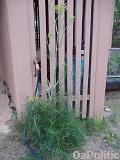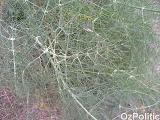|
Fennel
Previous
Next
Up
Home

I really only grow fennel because I am such a keen fishermen and it is a good garnish for fish. It also goes well in roasts. It has a pleasant aniseed flavour and I often graze on it when I am in the garden. It has a very mild flavour in cooking. The leaves are thin and stringy, not flat. The great thing about fennel is that it is so long lived. I have some growing under a tap that must be two years old by now. It is very low maintenance.
Fennel (Foeniculum vulgare) is a species in the genus Foeniculum (treated as the sole species by many botanists), and is native to southern Europe (especially the Mediterranean) and southwestern Asia. It is a member of the family Apiaceae, formerly the Umbelliferae.
 It is a highly aromatic perennial herb, erect, glaucous green, and grows to 2 m tall. The leaves grow up to 40 cm long; they are finely dissected, with the ultimate segments filiform, about 0.5 mm wide. The flowers are produced in terminal compound umbels 5–15 cm wide, each umbel section with 20–50 tiny yellow flowers on short pedicels. The fruit is a dry seed from 4–9 mm long, half as wide or less, and grooved.
It is a highly aromatic perennial herb, erect, glaucous green, and grows to 2 m tall. The leaves grow up to 40 cm long; they are finely dissected, with the ultimate segments filiform, about 0.5 mm wide. The flowers are produced in terminal compound umbels 5–15 cm wide, each umbel section with 20–50 tiny yellow flowers on short pedicels. The fruit is a dry seed from 4–9 mm long, half as wide or less, and grooved.
Fennel is used as a food plant by the larvae of some Lepidoptera species including the Mouse Moth and the Anise Swallowtail.
Cultivation and uses
Fennel is widely cultivated -- both in its native range and elsewhere -- for its edible, strongly-flavoured leaves and seeds. The flavour is similar to that of anise and star anise, though usually not so strong.
The Florence fennel (F. vulgare Azoricum Group) is a selection with inflated leaf bases which form a sort of bulb. It comes mainly from India and Egypt and it has a mild anise-like flavour, but is more aromatic and sweeter. Its flavour comes from anethole, an aromatic compound also found in anise and star anise. Florence fennel is smaller than the wild type and has inflated leaf bases which are eaten as a vegetable, both raw and cooked. There are several cultivars of Florence fennel, which is also known by several other names, notably the Italian name finocchio. In North American supermarkets, it is often mislabeled as "anise".
Fennel has become naturalised along roadsides, in pastures, and in other open sites in many regions, including northern Europe, Cyprus, the United States, southern Canada and in much of Asia and Australia.
It propagates well by seed, and is considered an invasive species and a weed in Australia and the United States.
Florence fennel was one of the three main herbs used in the preparation of Absinthe, an alcoholic mixture which originated as a medicinal elixir in Switzerland and became, by the late 1800s, a popular drink believed by many to have psychoactive properties beyond those found in other alcoholic beverages. Due to these beliefs, Absinthe was banned in most countries by the 1940s, but a recent relaxation of laws governing its production, importation and sale has caused a moderate resurgence in consumption. Many modern preparations marketed under the name "Absinthe" do not, however, make use of fennel as did the traditional recipes.
Culinary uses
The bulb, foliage, and seeds of the fennel plant all have secure places in the culinary traditions of the world. Fennel pollen is the most potent form of fennel, but it is exceedingly expensive. Dried fennel seed is an aromatic, anise-flavoured spice; they are brown or green in colour when fresh, and slowly turn a dull grey as the seed ages. For cooking, green seeds are optimal.
Fennel seeds are sometimes confused with aniseed, which is very similar in taste and appearance, though smaller. Indians often chew fennel seed (or saunf) as a mouth-freshener. Fennel is also used as a flavouring in some natural toothpastes. Some people employ it as a diuretic, while others use it to improve the milk supply of breastfeeding mothers.
Many cultures in the Indian subcontinent and the Middle East incorporate fennel seed into their culinary traditions. It is an essential ingredient in the Bengali/Oriya spice mixture panch phoron and in Chinese five-spice powders. It is known as saunf or moti saunf in Hindi and Urdu, mouri in Bengali, and shombu in the Tamil language. In the west, fennel seed is a very common ingredient in Italian sausages and northern European rye breads.
Many egg, fish, and other dishes employ fresh or dried fennel leaves. Florence fennel is a key ingredient in some Italian and German salads, often tossed with chicory and avocado, or it can be braised and served as a warm side dish. One may also blanch and/or marinate the leaves, or cook them in risotto. In all cases, the leaves lend their characteristically mild, anise-like flavour.
Medical uses
Essential oil of Fennel is included in some pharmacopoeias. It is traditionally used in drugs to treat chills and stomach problems.
Fennel leaves can be boiled, the steam inhaled to relieve croup, asthma, and bronchitis.
Perfumery
Fennel essential oil is used in soaps, and some perfumes.
Etymology and history
Etymologically, the word fennel developed from Middle English fenel, fenyl; Anglo-Saxon fenol, finol, from Latin feniculum, fśniculum, diminutive of fenum, fśnum, "hay".
In Ancient Greek, fennel was called marathon, and is attested in Linear B tablets as ma-ra-tu-wo. This is the origin of the placename Marathon (meaning place of fennel), site of the Battle of Marathon in 490 BC. Greek mythology claims Prometheus used the stalk of a fennel plant to steal fire from the gods.
In medieval times fennel was used in conjunction with St John's wort to keep away witchcraft and other evil things. This might have originated because fennel can be used as an insect repellent.
Fennel is thought to be one of the nine herbs held sacred by the Anglo-Saxons. The other eight are not entirely certain, but were probably mugwort (Artemisia vulgaris), greater plantain (Plantago major), watercress (Nasturtium officinale), wild chamomile (Matricaria recutita), stinging nettle (Urtica dioica), crab apple (Malus sylvestris), chervil (Anthriscus cerefolium), and viper's bugloss (Echium vulgare).
Pharmacological action
Fennel contains Anethole, an antispasmatic, alongside other pharmacologically active substances.
|